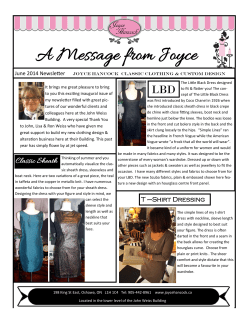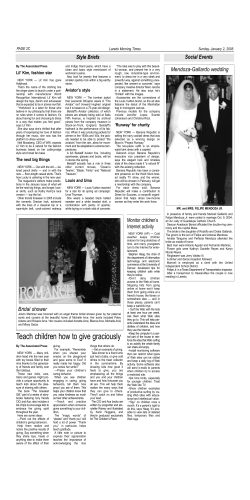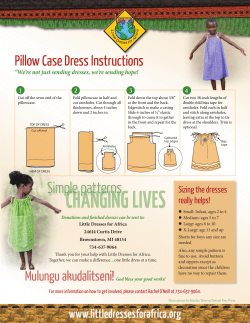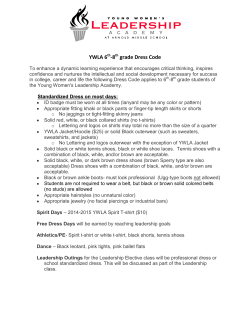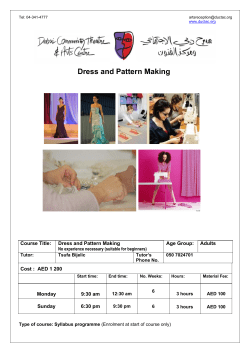
TOXICOLOGY Case: DRESS Syndrome LETTER 1-800-222-1222
New York State Poison Centers The NY State Poison Centers 1-800-222-1222 October 2008 TOXICOLOGY LETTER A Quarterly Publication • Vol. XIII No. 4 Case: DRESS Syndrome Contributed by: Daniel Lugassy, M.D., Medical Toxicology Fellow, Lewis Nelson, M.D., Director, Fellowship in Medical Toxicology, New York City Poison Control Center, NY, NY Case Report: Program Announcements •• Ruth A. Lawrence: Monthly conference: every 4 weeks on Thursdays (11 am to noon), and every 4 weeks on Tuesdays (10 am-11 am). UNY: Our Twelfth Annual Toxicology Teaching Day will be held on November 5, 2008 at the Genesee Grand Hotel in Syracuse. Please mark your calendar! NYC: Consultants Case Conference • The first Thursday of the Month from 2-4pm Long Island Regional Poison and Drug Information Center: Please look for our fall programs Please call administrative telephone numbers for more information. A 63 year-old Chinese woman presents to the emergency department (ED) complaining of a rash that started two days earlier, as well as fever and decreased appetite. She has a history of mixed connective tissue disorder, hypertension, diabetes, and psoriatic arthritis. She completed a course of azithromycin about one week ago for an upper respiratory infection. Due to the persistence of symptoms her doctor prescribed clotrimazole lozenges and trimethoprim-sulfamethoxazole two days prior to arrival. In addition to these medications above, she takes numerous medications daily for her chronic conditions, which her husband states he will bring to the hospital later. Upon initial physical examination, she was awake, alert and oriented. Vital signs were: blood pressure, 119/55 mmHg; heart rate 92 beats/minute; respiratory rate 18 breaths/minute; and temperature 99.8˚ F. A diffuse blanchable maculopapular rash was noted on upper and lower extremities, chest, and abdomen. No rash was present on her palms or soles and there was no mucosal involvement. Scleral icterus and mild abdominal tenderness were the only other significant exam findings. Initial pertinent laboratory results were as follows: Complete blood count: white blood cell count, 12,300 cells/mm3; and an absolute eosinophil count of 861 cells/mm3. Chemistry: sodium 124 mEq/L, potassium 5.2 mEq/L, chloride 106 mEq/L, bicarbonate 10 mEq/L, blood urea nitrogen 38 mg/dL, creatinine 1.6 mg/dL, glucose 277 mg/dL. Hepatic studies: AST 1,063 IU/L; ALT 604 IU/L; alkaline phosphatase 1425 IU/L, total bilirubin 7.3 mg/dL; direct bilirubin 5.3 mg/dL; albumin 3.4 gm/dL. NY State Poison Centers • 1.800.222.1222 Continued on page 6 1 FDA Safety Summaries Statin drugs and amyotrophic lateral sclerosis (ALS) An FDA analysis provides new evidence that the use of statins does not increase incidence of amyotrophic lateral sclerosis (ALS), a neurodegenerative disease often referred to as “Lou Gehrig’s Disease.” September 29, 2008 Rituxan (rituximab) Genentech informed healthcare professionals of revisions to prescribing information for Rituxan regarding a case of progressive multifocal leukoencephalopathy (PML) leading to death in a patient with rheumatoid arthritis who received Rituxan in a longterm safety extension clinical study. September 2008 Epoetin alfa - Early Communication about an Ongoing Safety Review FDA has been made aware of preliminary safety findings from a clinical trial conducted in Germany investigating the use of epoetin alfa to treat acute ischemic stroke. The clinical trial utilized doses of epoetin alfa that were considerably higher than the doses recommended for the treatment of anemia as described in the FDA-approved labeling for the product. Over a period of ninety days after the start of the trial, there were more deaths in the group of patients who received epoetin alfa compared to patients who received the placebo (16% versus 9%). September 26, 2008 Tumor necrosis factor-alpha blockers (TNF blockers), Cimzia (certolizumab pegol), Enbrel (etanercept), Humira (adalimumab), and Remicade (infliximab) FDA notified healthcare professionals that pulmonary and disseminated histoplasmosis, coccidioidomycosis, blastomycosis and other opportunistic infections are not consistently recognized in patients taking tumor necrosis factor-a blockers (TNF blockers). September 4, 2008 Ammonul (sodium phenylacetate and sodium benzoate) Injection 10%/10% Ucyclyd Pharma, Inc. informed healthcare professionals of the detection of particulate matter in the Ammonul Injection product. September 15, 2008 Tarceva (erlotinib) OSI and Genentech notified healthcare professionals that cases of hepatic failure and hepatorenal syndrome, including fatalities, have been reported during use of Tarceva, particularly in patients with baseline hepatic impairment. September 12, 2008 Phosphocol P 32 (Chromic Phosphate P 32 Suspension) Covidien and Mallinckrodt Inc. informed healthcare professionals of important new safety information in prescribing Phosphocol P 32. Phosphocol P 32 is approved for the intracavitary instillation for the treatment of peritoneal or pleural effusions caused by metastatic disease. Phosphocol P 32 may increase the risk for leukemia in certain situations. August 29, 2008 Infant Formula Manufactured in China FDA issued a Health Information Advisory to consumers and healthcare professionals regarding milk-based infant formula manufactured in China. The Chinese manufactured infant formula may be contaminated with melamine. Melamine artificially increases the protein profile of milk and can cause kidney diseases. September 20, 2008 Tysabri (natalizumab) FDA informed healthcare professionals of two new cases of progressive multifocal leukoencephalopathy (PML) in European patients receiving Tysabri monotherapy for multiple sclerosis for more than one year. August 25, 2008 Ezetimibe/Simvastatin (marketed as Vytorin) Simvastatin (marketed as Zocor) Ezetimibe (marketed as Zetia) FDA informed healthcare professionals that the Agency is investigating a report from the Simvastatin and Ezetimibe in Aortic Stenosis (SEAS) trial of a possible association between the use of Vytorin and a potentially increased incidence of cancer. August 21, 2008 Vivitrol (naltrexone) FDA informed healthcare professionals of the risk of adverse injection site reactions in patients receiving naltrexone. August 12, 2008 Simvastatin Used With Amiodarone FDA notified healthcare professionals of the risk of muscle injury, rhabdomyolysis, which can lead to kidney failure or death, when simvastatin is used with amiodarone. August 08, 2008 Viapro 375mg Capsules EG Labs, LLC, notified consumers and healthcare professionals not to buy or use Viapro 375mg Capsules because one lot of the product was found to contain a potentially harmful undeclared ingredient, thio-methisosildenafil, an analog of sildenafil, a FDA approved Continued on page 3 2 NY State Poison Centers • 1.800.222.1222 FDA Safety Summaries product used to treat erectile dysfunction in men to enhance sexual performance. July 23, 2008 Erythropoiesis Stimulating Agents (ESAs) Epoetin alfa (marketed as Procrit, Epogen), Darbepoetin alfa (marketed as Aranesp) Changes clarify the FDA-approved conditions for use of ESAs in patients with cancer and revise directions for dosing to state the hemoglobin level at which treatment with an ESA should be initiated. August 7, 2008 Mitoxantrone Hydrochloride (marketed as Novantrone and generics) FDA reminded health care professionals who treat patients with mitoxantrone about recommendations that left ventricular ejection fraction (LVEF) be evaluated before initiating treatment and prior to administering each dose of mitoxantrone. July 29, 2008 Continued from page 2 Abacavir (marketed as Ziagen) and Abacavircontaining Medications FDA informed healthcare professionals that serious and sometimes fatal hypersensitivity reactions (HSR) caused by abacavir therapy are significantly more common in patients with a particular human leukocyte antigen (HLA) allele, HLA-B*5701. July 24, 2008 Sodium Polystyrene Sulfonate Suspension Roxane Laboratories, Inc. informed healthcare professionals of the recall of two lots of Sodium Polystyrene Sulfonate Suspension, USP, 15 g/60 mL Unit dose bottles (NDC 0054-0165-51; lot 856396A Exp April 2010, and lot 856693A Exp May 2010), a product used to treat hyperkalemia. A sample of one of the affected lots tested positive for a strain of yeast, which could potentially affect immunocompromised patients. July 14, 2008 Avastin (bevacizumab) Genentech, Inc. informed healthcare professionals of reports of several cases of microangiopathic hemolytic anemia (MAHA) in patients with solid tumors receiving Avastin in combination with sunitinib malate. July 11, 2008 Herceptin 440 mg Vials and BWFI Diluent Genentech informed healthcare professionals that an increased number of complaints were received regarding damaged and broken vials of Herceptin 440 mg and BWFI (bacteriostatic water for injection) diluent. June 28, 2008 Fluoroquinolone Antimicrobial Drugs FDA notified healthcare professionals that a BOXED WARNING and Medication Guide are to be added to the prescribing information to strengthen existing warnings about the increased risk of developing tendinitis and tendon rupture in patients taking fluoroquinolones for systemic use. July 08, 2008 Rize 2 The Occasion Capsules Rose 4 Her Capsules Jack Distribution, LLC, announced a nationwide recall of all lot numbers of the company’s supplement products sold under the brand names Rize 2 The Occasion and Rose 4 Her. Lab analysis by FDA of samples of random lots found the product contains a potentially harmful, undeclared ingredient, thiomethisosildenafil, an analog of sildenafil, the active ingredient of a FDA-approved drug used for erectile dysfunction. July 28, 2008 NY State Poison Centers • 1.800.222.1222 3 ?DIC Questions from the Drug Information Center Contributed by: Nicholas Steidl, Pharm.D., Clinical Toxicology Fellow, Upstate NY Poison Center, Syracuse NY Question: Is multiple dose activated charcoal (MDAC) effective in the setting of salicylate poisoning? Background: A 17 y/o male presented with nausea and tinnitus 12 hours following an overdose on aspirin. He was subsequently started on bicarbonate to achieve serum and urine alkalinization and MDAC to enhance excretion of salicylate. A question on the utility of MDAC in this situation and with salicylate poisoning in general arose. Summary: While there is a potential theoretical benefit of MDAC in the setting of salicylate overdose the evidence is inconclusive and clinical benefit has not been proven. There is no role for late administration of MDAC at 12 hours and there is insufficient evidence to recommend its routine use in early presenters. Answer: There are several reasons that MDAC is employed in certain poisoning cases. It may be useful in cases where there is the potential for ongoing absorption and the amount of drug exceeds the binding capacity of a single dose of charcoal. While in most cases salicylates are rapidly absorbed there are some situations in which absorption may be prolonged. Salicylates are known to cause pylorospasm and enteric-coated formulations can form concretions in the stomach.1 In large overdoses maximal peak concentrations may not be reached for 4-6 hours. In cases such as this there is a theoretic benefit to administration of MDAC. MDAC is also indicated for use when the drug ingested undergoes significant entero-hepatic recirculation. Salicylates and their metabolites are primarily eliminated in the urine and only trace amounts are eliminated in the feces or by other routes. Therefore there is almost no capacity for entero-hepatic recir4 culation and MDAC will not cause benefit from this mechanism.1 In addition the use of MDAC may facilitate reverse diffusion of drug from the circulation into the gastrointestinal tract by binding drug in the gut, setting up a concentration gradient. This is referred to as “gut-dialysis.1” In a pig model MDAC had no effect on clearance of 300 mg/kg IV aspirin demonstrating that this effect is not significant with salicylates.6 While theoretic benefit exists, trials in humans have exhibited mixed results. Mayer et al. studied 9 patients in a crossover trial in which he gave 2880 mg aspirin followed by 25 g AC at 4, 6, 8, and 10 hours and compared it to control. There was no significant difference found in the AUC between the groups (control: 2320 ± 501 mg/Lh vs. MDAC: 2040 ± 454 mg/Lh, NS).2 Similarly, Ho et al. evaluated the administration of 55 g AC at the same time intervals after administration of 1300 mg aspirin in a crossover study of 6 patients and found no significant differences in AUC.3 A notable limitation of these studies is that the dosing allowed cannot simulate toxic ingestions. In contrast, Kirshenbaum et al. did a similar evaluation in a crossover study of 10 patients and found a potential benefit. They gave 2880 mg aspirin followed by 25 g MDAC in the same dosing schedule as the previous trials. They observed a significant decrease in the AUC of 9% (p<0.05) in the MDAC group as well as an 18% decrease in urinary excretion (p<0.01).4 While statistically significant it is important to note that this effect is small and of questionable clinical significance, however the potential for a greater benefit in the overdose setting exists. Barone et al. also showed a potential benefit of MDAC after administration of twenty-four 81 mg aspirin tablets. They compared urinary excretion of salicylates in a four-limbed crossover study of 10 vol- NY State Poison Centers • 1.800.222.1222 Continued on page 7 ?DIC Questions from the Drug Information Center Contributed by: Nasreen Dharsee, Pharm.D. Candidate, Mary Ann Howland, Pharm.D., DABAT, St. John’s University, New York City Poison Control Center, NY, NY Howland Question: Should a patient experiencing priapism with trazadone refrain from alphablockers? Answer: Trazodone is triazolopyridine derivative that works as a selective inhibitor of neuronal serotonin uptake and also has peripheral serotonin antagonist and alpha-adrenergic antagonist effects1. It has been used in the United States since 1982 as an antidepressant with minimal anticholinergic effects1. Since trazodone has a sedative property, it is commonly used as a sleeping agent at a low dose. Other common adverse effects of trazodone include anorexia, blurred vision, sweating, weight changes, orthostasis, dizziness, headache, memory impairment, insomnia, and gastrointestinal effects, including nausea, vomiting, diarrhea, and dry mouth2. Rare, serious side effects include arrhythmias, hyper- or hypotension, hemolytic anemia, leukocytosis, methemoglobinemia, and seizures2. One of the more common, but extremely painful serious complicated associated with the use of trazodone is priapism. During the period from 1982 to 1988, at least 20 cases of priapism with trazodone therapy were reported. These occurred in patients ages 24 to 60 who were taking standard doses of 100–600 mg per day for a duration ranging from 6 days to 4 weeks1. Priapism is an uncommon condition that causes a prolonged and often painful erection, which occurs without sexual stimulation. In one-third of the cases, the cause of the disorder is unknown3. The remaining cases are caused by an associated condition, including sickle cell disease, pelvic tumors, pelvic infections, leukemia, genital trauma or spinal cord trauma and medications or recreational drugs3. Associations have been demonstrated between ischemic priapism and many medications with alpha-adrenergic blocking activity or central serotonin-like activity1. Alpha-adrenoceptor antagonism is the most likely mechanism; constriction of the blood vessels supplying erectile tissue is prevented and detumescence does not occur. Prazosin is the drug most frequently associated with priapism3. Surprisingly, there is no study directly correlating not using alpha blockers in patients that have experienced trazodone induced priapism. The physician, however, may choose to keep a patient off alpha blockers because if they take trazodone and experience priapism, it is most likely due to the alpha-blocking activity of this drug. Therefore, any additional alphablockers thereafter should be avoided because the alpha-blocking activity is higher in direct alpha-blockers than in trazodone, and priapism will become a serious risk and complication for this patient. References: 1. Jayaram, Rao. Safety of Trazodone as a Sleeping Agent for Inpatients. Psychosomatics 46:4, July-August 2005. http://psy.psychiatryonline.org/cgi/reprint/46/4/367 2. Lexi-Comp online. Trazodone. 1978-2008. Hudson, Ohio www.crlonline.com 3. Health Care Specialists at UCSF Medical Center. Male Sexual Function: Priapism. May 8th, 2007. http://www.ucsfhealth.org/adult/medical_services/urology/ male_sexual/conditions/priapism/diagnosis.html NY State Poison Centers • 1.800.222.1222 5 Case: DRESS Syndrome Continued from page 1 What clinical syndrome should be considered in this case? This patient appears to be having a severe adverse cutaneous drug reaction that included abnormalities of bone marrow, liver and renal function. Together these form the basis for the DRESS syndrome, an acronym for “drug rash with eosinophilia and systemic symptoms.” DRESS syndrome is commonly accepted to include previously described drug hypersensitivity syndromes such as for anticonvulsant or sulfonamides syndrome. How does one make the diagnosis of DRESS syndrome? The triad of rash, fever and internal organ involvement are the key features in making this diagnosis. It is usually seen 2-8 weeks after the initiation of a new drug or within a day of re-exposure. The rash, which can vary in appearance and severity, is most commonly morbilliform (measles-like). The eruption of the rash often precedes or coincides with the development of a fever and non-specific findings including malaise, pharyngitis, facial edema, and lymphadenopathy. DRESS may be clinically indistinguishable from other cutaneous syndromes such as Stevens-JohnsonSyndrome/Toxic Epidermal Necrolysis (SJS/TEN), Kawasaki disease, Still’s disease, and bacterial infections. SJS/TEN, a life threatening cutaneous drug rash, differs from DRESS in that SJS/TEN features prominent mucosal involvement, target lesions, and epidermal necrosis leading to skin sloughing. The diagnosis of DRESS requires the presence of eosinophilic infiltration of the internal organs. This most commonly manifests as acute hepatitis, and can progress to fulminant hepatic failure. Interstitial nephritis, encephalitis, pneumonitis, and thyroiditis are also relatively common. Internal organ involvement is determined initially through laboratory analysis, which should include renal, hepatic, and thyroid studies. The initial studies of bone marrow activity (e.g. CBC with differential) demonstrate atypical lymphocytes and eosinophilia. Which medications have been observed to cause DRESS syndrome? Anticonvulsants and sulfonamides have been the most common drugs reported to cause DRESS syndrome, with an incidence ranging from 1 in 1,000 to 1 in 10,000 exposures. Some of the other drugs implicated in this syndrome include: phenytoin, carbamazepine, phenobarbital, lamotrigine, minocycline, dapsone, allopurinol, nevirapine, and abacavir. Case Continuation: The patient’s husband brought to the hospital a large bag of medications including the following: acetylsalicylic acid, allopurinol, folic acid, gemfibrozil, glipizide, lansoprazole, leflunomide, metformin, simvastatin, and valsartan. The prescriptions came from several different pharmacies and physicians. The patient had only taken two or three doses of trimethoprim-sulfamethoxazole before her symptoms began, and further investigation by calling several of her primary care physicians and pharmacies revealed that she had never previously used this drug, making this an unlikely etiologic factor. Allopurinol was initiated six weeks prior to presentation, making it the most likely cause of DRESS syndrome in this patient. What is the mechanism of DRESS syndrome? The exact cause of DRESS is unclear and for each drug a different mechanism may exist. Most proposed mechanisms infer an unwarranted immunological response to the drug itself or its metabolites. For example, various endogenous enzymes create active metabolites from aromatic anticonvulsants that are thought to be detoxified by epoxide hydroxylase. If this process is faulty these metabolites may induce an auto immune response by creating neoantigens to which the immune system responds. Evidence also suggests that active human herpes virus 6 infection may also play a role by interfering with the removal of toxic drug metabolites. Continued on page 7 6 NY State Poison Centers • 1.800.222.1222 Case: DRESS Syndrome How is DRESS syndrome treated? Nothing is more important to reducing morbidity and mortality than rapid recognition of DRESS syndrome and immediate cessation of all potential offending agents. Corticosteroid treatment to suppress the inflammatory eosinophilic involvement of the skin and internal organs remains controversial for several reasons. Viral activation may play a role in the cause of DRESS syndrome and there are concerns that systemic corticosteroids may enhance this process. Corticosteroids do not seem to have an outcome benefit in similar diseases such as in SJS/TEN, likely due to the increased septic complications associated with the presence of mucocutaneous lesions. But complications of DRESS syndrome are more commonly due to internal organ derangement rather than cutaneous effects. Despite the lack of randomized control trials and the potential harm, systemic corticosteroids are typically recommended and many patients seem to respond favorably. Question from... Continued from page 4 unteers after administration of 0, 1, 2, and 3 doses of 50 g AC separated by 4 hours. They found that 3 doses of AC showed a significant reduction in % urinary excretion as compared to control, 1 and 2 doses (49.2 vs. 91.0, 68.3, and 65.9% respectively, p<0.01 for each).5 Unfortunately data on serum concentrations was not gathered which is a limitation as effects on absorption were not directly measured. In addition clinical significance in the effect on outcome cannot be surmised. References: 1. Flomenbaum NE. Salicylates. In: Goldfrank LR, Flomenbaum NE, Lewin NA, et al. Goldfrank’s Toxicologic Emergencies. 8th ed. New York, NY: McGraw-Hill; 2006. 2. Mayer AL, et al. Multiple-dose charcoal and whole-bowel irrigation do not increase clearance of absorbed salicylate. Arch Intern Med. 1992 Feb;152(2):393-6. 3. Ho JL, Tierney MG, Dickinson GE. An evaluation of the effect of repeated doses of oral activated charcoal on salicylate elimination. J Clin Pharmacol 1989;29:366– 369. 4. Kirshenbaum LA, Mathews SC, Sitar DS, Tenenbein M. Does multiple-dose charcoal therapy enhance salicylate excretion? Arch Intern Med. 1990 Jun;150(6):1281-3. 5. Barone JA, Raia JJ, Huang YC. Evaluation of the effects of multiple-dose activated charcoal on the absorption of orally administered salicylate in a simulated toxic ingestion model. Ann Emerg Med. 1988 Jan;17(1):34-7. 6. Johnson D, et al. Effect of multiple-dose activated charcoal on the clearance of high-dose intravenous aspirin in a porcine model. Ann Emerg Med. 1995 Nov;26(5):569-74. Continued from page 6 IV N-acetylcysteine is used to treat DRESS syndrome related hepatitis, given its proven nonspecific beneficial role in a variety of other causes of fulminant hepatic failure. But this therapy remains unproved and controversial, with benefit suggested in some case reports and possibly an increased rate of anaphylactoid reactions in others. Although DRESS is typically due to a specific drug, other drugs in a similar class, such as the aromatic anticonvulsants (i.e, phenobarbital, phenytoin, carbamazepine), may cause a similar reaction in an affected individual. Therefore patients who survive DRESS syndrome need specific education and ongoing medication reconciliation to prevent exposure to other potential offending agents. Evidence has linked genetic components to several medications that are known to cause DRESS syndrome, therefore counseling family members must be a part of treatment. It has been described that in patients of Chinese descent there is a very strong association with HLA-B*5801 allele and DRESS syndrome caused by allopurinol. This patient is an immigrant from China. Case Conclusion: Shortly after presenting to the ED, the patient became obtunded and an ABG showed: pH,7.1; pCO2, 30 mmHg; pO2, 62 mmHg; bicarbonate, 9 mEq/L. Her initial clinical course was complicated by respiratory failure requiring intubation, fulminant hepatic failure, refractory hypotension requiring vasopressors, and renal failure requiring hemodialysis. She was given a course of IV N-acetylcysteine, and IV corticosteroids. After two weeks her liver and renal failure improved dramatically, but she suffered from several hospital related septic complications . Her family was educated on the potential for a genetic link. Bibliography 1: Bocquet H, Bagot M, Roujeau JC. Drug-induced pseudolymphoma and drug hypersensitivity syndrome (Drug Rash with Eosinophilia and Systemic Symptoms: DRESS). Semin Cutan Med Surg 1996;15:250-7. 2: Shalom R, Rimbroth S, Rozenman D, Markel A. Allopurinolinduced recurrent DRESS syndrome: Pathophysiology and treatment. Ren Fail 2008;30:327-9. 3: Markel A. Allopurinol-induced DRESS syndrome. Isr Med Assoc J 2005;7:656-60. 4: Tas S, Simonart T. Management of drug rash with eosinophilia and systemic symptoms (DRESS syndrome): An update. Dermatology 2003;206:353-6. 5: Knowles SR, Shear NH. Recognition and management of severe cutaneous drug reactions. Dermatol Clin 2007;25:245-53. 6: Hung SI, Chung WH, Liou LB, et al.. HLA-B*5801 allele as a genetic marker for severe cutaneous adverse reactions caused by allopurinol. Proc Natl Acad Sci USA 2005;102:4134-9. Erratum in: Proc Natl Acad Sci USA 2005 26;102:6237. NY State Poison Centers • 1.800.222.1222 7 Toxicology Advice Centers •• Administrative Phone Numbers - To obtain a consult in your area, call 1.800.222.1222. Western New York Poison Center (WNY) . . . . . . . . . . . . . . . . . . . . . . . . . . . . . . 716.878.7871 • http://wnypoison.org Ruth A. Lawrence NY Poison Center (FL) . . . . . . . . . . . . . . . . . . . . . . . . 585.273.4155 • www.FingerLakesPoison.org Upstate New York Poison Center (UNY) . . . . . . . . . . . . . . . . . . . . . . . . . . . . . 315.464.7078 • www.upstatepoison.org New York City Poison Control Center (NYC) . . . . . . . . . . . . . . . . . . . . . . . . . . . . . . . . . . . . . . . . . . . . . . . . . 212.447.8152 Long Island Poison & Drug Info Center (LI) . . . . . . . . . . . . . . . . . . . . . . . . . . . . . . 516.663.4574 • www.LIRPDIC.org This Publication is printed with permission of the State University of New York, Upstate Medical University, Syracuse, New York 13210 Upstate NY Poison Center 750 East Adams Street Syracuse, NY 13210
© Copyright 2025


